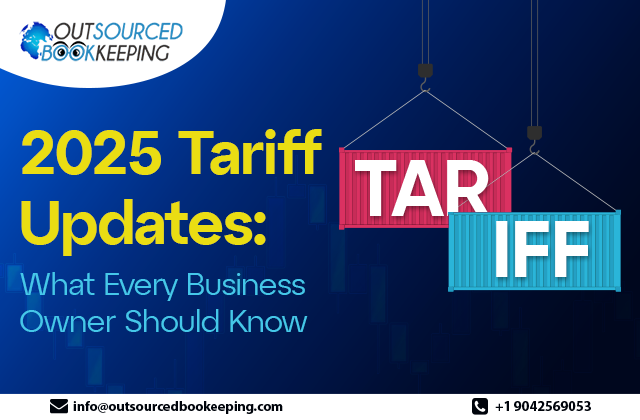With the changing global economy and the new trade policies, tariff updates are back in the business discussions. New policies introduced by the U.S government are already altering the way that companies approach imports, pricing and financial control. This is particularly important for companies that rely on imports of supplies or exports of their products, since they need to adapt to these changes to remain competitive and financially sustainable.
The current landscape is marked by a series of new and increased tariffs, impacting everything from raw materials to consumer goods. With global supply chains still adjusting to the effects of past disruptions, these tariff updates for business owners demand a proactive response.

Overview of the 2025 Tariff Revisions
2025 tariffs and business strategy are driven by the changing global economy and new trade policies. New policies that have been introduced by the U.S. government are already altering the way that companies approach imports, pricing, and financial control. This is particularly important for companies that rely on imports of supplies or exports of their products, since they need to adapt to these changes to remain competitive and financially sustainable.
The current environment is characterized by new and higher tariffs on various products, ranging from the basic raw materials to the final products. As the global supply chains are still recovering from the impacts of previous disruptions, these shifts require a strategic approach from business owners.
Overview of the 2025 Tariff Revisions
From April 2025, the U.S. government decided to apply a 10% across-the-board tariff on all imported goods. Additional hikes were made for products imported from countries with large trade imbalances with the U.S., such as steel, aluminum, and auto parts. Also, the current tariff of 25% has been placed on all imported automobiles and some parts.
One of the most shocking changes that affected many companies was the re-imposition of tariffs on imports of low-value products from China. Known as the de minimis threshold rollback, this policy eliminates duty-free status for many small shipments. This change, which is to take effect from May 2025, will mean that even small imports are going to be subjected to formal customs clearance and the related charges.
These tariffs are aimed at preserving domestic industries and decreasing the dependence on imports. However, the increase in operational costs is making companies look for ways to counter it.
The Impact of 2025 Tariffs on Businesses
The impact of 2025 tariffs on businesses is evident in various industries. Some industries that have been most affected include the retail sector, the automotive industry, and electronics, where companies that source most of their products from overseas are experiencing a rise in production and procurement costs.
For small businesses, the elimination of the de minimis rule entails extra procedures and customs costs on previously non-taxable low-value imports. These costs may not be very much at one time, but they can be significant when importing in large quantities or frequently.
From a cash flow point of view, these new tariff updates can also cause shifts in the unplanned budget. When tracking and forecasting are not done well, it becomes possible for the company to set its price lower than the actual cost of goods sold, which affects profitability.
Business Planning for 2025 Tariffs
The foundation of business planning for 2025 tariffs is awareness and flexibility. Business owners should begin by evaluating their supply chains and identifying which products or materials are most impacted by the new tariffs. This makes it possible to forecast the rise in costs and search for ways to reduce costs.
In some circumstances, companies may be able to diversify suppliers, source domestically, or renegotiate contracts with international partners to pass the costs of tariffs. It also helps to reduce the financial risk and, at the same time, increases the supply chain robustness.
It is also necessary to recall the budgeting procedures. Due to the increase in import duties, the expenses should be adjusted to reflect the actual costs of tariffs and customs fees. These updated budgets will help in making better decisions regarding the pricing and marketing of the products throughout the year.
In addition, companies should consult with financial advisors or bookkeepers to incorporate the tariff costs into financial planning. This will help in checking compliance and also in preparing for the next tax season.
Tariff and Tax Considerations for 2025
One of the areas that has been given little attention when it comes to tariff updates is the impact on tax reporting. Tariffs raise the cost of imported goods, which has implications for the inventory and expenses. This has an impact on the reported income and taxable profit.
In order to make correct estimations of taxes, it is necessary to keep records of all imports and costs associated with tariffs. New formal customs entries have been introduced for many low-value items. Therefore, additional documentation to support expense claims and inventory valuations is required.
The process of including tariffs in the end-of-year tax returns involves collaboration between the procurement, finance, and tax departments. This will not only help in avoiding penalties but also enable the businesses to maximize the allowable deductions here.
Final Thoughts
The tariff changes for businesses 2025 are a threat and a potentiality at the same time. Although cost and regulation may be the biggest challenges, any company that is strategic and proactive can manage this environment effectively.
It is crucial to stay abreast of the tariffs. Thus, being aware of the changes, reevaluating supply chains, and consulting with financial advisors, business owners can reduce the impact of the shift and ensure their companies’ sustainable development in a new economy.


